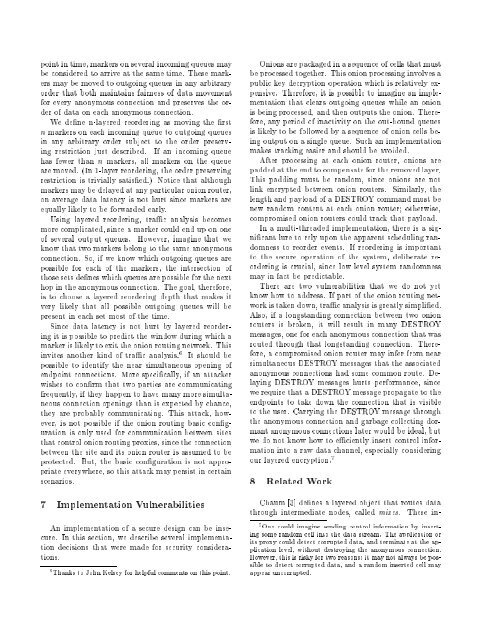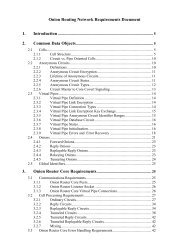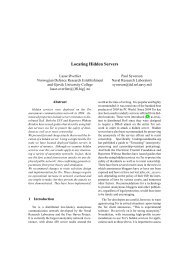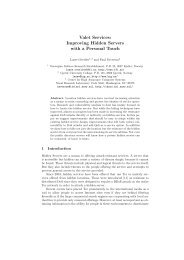Anonymous Connections and Onion Routing
Anonymous Connections and Onion Routing
Anonymous Connections and Onion Routing
You also want an ePaper? Increase the reach of your titles
YUMPU automatically turns print PDFs into web optimized ePapers that Google loves.
point in time, markers on several incoming queues may<br />
be considered to arrive at the same time. These markers<br />
may bemoved to outgoing queues in any arbitrary<br />
order that both maintains fairness of data movement<br />
for every anonymous connection <strong>and</strong> preserves the order<br />
of data on each anonymous connection.<br />
We dene n-layered reordering as moving the rst<br />
n markers on each incoming queue to outgoing queues<br />
in any arbitrary order subject to the order preserving<br />
restriction just described. If an incoming queue<br />
has fewer than n markers, all markers on the queue<br />
are moved. (In 1-layer reordering, the order preserving<br />
restriction is trivially satised.) Notice that although<br />
markers may be delayed at any particular onion router,<br />
on average data latency is not hurt since markers are<br />
equally likely to be forwarded early.<br />
Using layered reordering, trac analysis becomes<br />
more complicated, since a marker could end up on one<br />
of several output queues. However, imagine that we<br />
know that two markers belong to the same anonymous<br />
connection. So, if we know which outgoing queues are<br />
possible for each of the markers, the intersection of<br />
those sets denes which queues are possible for the next<br />
hop in the anonymous connection. The goal, therefore,<br />
is to choose a layered reordering depth that makes it<br />
very likely that all possible outgoing queues will be<br />
present in each set most of the time.<br />
Since data latency is not hurt by layered reordering<br />
it is possible to predict the window during which a<br />
marker is likely to exit the onion routing network. This<br />
invites another kind of trac analysis. 6 It should be<br />
possible to identify the near simultaneous opening of<br />
endpoint connections. More specically, if an attacker<br />
wishes to conrm that two parties are communicating<br />
frequently, if they happen to have many more simultaneous<br />
connection openings than is expected by chance,<br />
they are probably communicating. This attack, however,<br />
is not possible if the onion routing basic conguration<br />
is only used for communication between sites<br />
that control onion routing proxies, since the connection<br />
between the site <strong>and</strong> its onion router is assumed to be<br />
protected. But, the basic conguration is not appropriate<br />
everywhere, so this attack may persist in certain<br />
scenarios.<br />
7 Implementation Vulnerabilities<br />
An implementation of a secure design can be insecure.<br />
In this section, we describe several implementation<br />
decisions that were made for security considerations.<br />
6<br />
Thanks to John Kelsey for helpful comments on this point.<br />
<strong>Onion</strong>s are packaged in a sequence of cells that must<br />
be processed together. This onion processing involves a<br />
public key decryption operation which is relatively expensive.<br />
Therefore, it is possible to imagine an implementation<br />
that clears outgoing queues while an onion<br />
is being processed, <strong>and</strong> then outputs the onion. Therefore,<br />
any period of inactivity on the out-bound queues<br />
is likely to be followed by a sequence of onion cells being<br />
output on a single queue. Such an implementation<br />
makes tracking easier <strong>and</strong> should be avoided.<br />
After processing at each onion router, onions are<br />
padded at the end to compensate for the removed layer.<br />
This padding must be r<strong>and</strong>om, since onions are not<br />
link encrypted between onion routers. Similarly, the<br />
length <strong>and</strong> payload of a DESTROY comm<strong>and</strong> must be<br />
new r<strong>and</strong>om content ateach onion router; otherwise,<br />
compromised onion routers could track that payload.<br />
In a multi-threaded implementation, there is a signicant<br />
lure to rely upon the apparent scheduling r<strong>and</strong>omness<br />
to reorder events. If reordering is important<br />
to the secure operation of the system, deliberate reordering<br />
is crucial, since low level system r<strong>and</strong>omness<br />
may in fact be predictable.<br />
There are two vulnerabilities that we do not yet<br />
know how to address. If part of the onion routing network<br />
is taken down, trac analysis is greatly simplied.<br />
Also, if a longst<strong>and</strong>ing connection between two onion<br />
routers is broken, it will result in many DESTROY<br />
messages, one for each anonymous connection that was<br />
routed through that longst<strong>and</strong>ing connection. Therefore,<br />
a compromised onion router may infer from near<br />
simultaneous DESTROY messages that the associated<br />
anonymous connections had some common route. Delaying<br />
DESTROY messages hurts performance, since<br />
we require that a DESTROY message propagate to the<br />
endpoints to take down the connection that is visible<br />
to the user. Carrying the DESTROY message through<br />
the anonymous connection <strong>and</strong> garbage collecting dormant<br />
anonymous connections later would be ideal, but<br />
we do not know how to eciently insert control information<br />
intoaraw data channel, especially considering<br />
our layered encryption. 7<br />
8 Related Work<br />
Chaum [3] denes a layered object that routes data<br />
through intermediate nodes, called mixes. These in-<br />
7 One could imagine sending control information by inserting<br />
some r<strong>and</strong>om cell into the data stream. The application or<br />
its proxy could detect corrupted data, <strong>and</strong> terminate at the application<br />
level, without destroying the anonymous connection.<br />
However, this is risky for two reasons: it may not always be possible<br />
to detect corrupted data, <strong>and</strong> a r<strong>and</strong>om inserted cell may<br />
appear uncorrupted.





